St. Vitus Cathedral - Prague
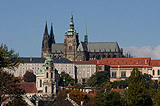 For more than 600 years, the roofs of Prague Castle have been overlooked by the towers of St Vitus Cathedral. The cathedral, whose original name is St Vitus, St Wenceslas and St Adalbert Cathedral, is the biggest and the most important church in the Czech Republic. It’s the seat of the Archbishop of Prague and the place where saints, kings, princes and pmperors of Bohemia are buried. The coronations of the kings of Bohemia were held there until 1836. It’s one of the best examples of Gothic architecture.
For more than 600 years, the roofs of Prague Castle have been overlooked by the towers of St Vitus Cathedral. The cathedral, whose original name is St Vitus, St Wenceslas and St Adalbert Cathedral, is the biggest and the most important church in the Czech Republic. It’s the seat of the Archbishop of Prague and the place where saints, kings, princes and pmperors of Bohemia are buried. The coronations of the kings of Bohemia were held there until 1836. It’s one of the best examples of Gothic architecture.
West side
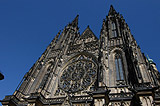 When you walk from the II courtyard to the III courtyard the first thing you notice is the impressive western part of St Vitus Cathedral. There is also the official main entrance to the cathedral. This part of the cathedral is the newest, it was built at the turn of the 19th and the 20th century (see St Vitus Cathedral History). The western part of the cathedral is characterized by two tall towers and the Rose Window. The author of this window, Frantisek Kysela, let himself inspire by old gothic windows in famous cathedrals in Paris. Notice four figures at the bottom of the window, two at at each side. They represent important people in the newest reconstruction of the cathedral.
When you walk from the II courtyard to the III courtyard the first thing you notice is the impressive western part of St Vitus Cathedral. There is also the official main entrance to the cathedral. This part of the cathedral is the newest, it was built at the turn of the 19th and the 20th century (see St Vitus Cathedral History). The western part of the cathedral is characterized by two tall towers and the Rose Window. The author of this window, Frantisek Kysela, let himself inspire by old gothic windows in famous cathedrals in Paris. Notice four figures at the bottom of the window, two at at each side. They represent important people in the newest reconstruction of the cathedral.
South side
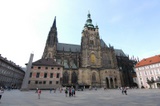 When you continue to the III courtyard pasing the Old Provosty, you may notice that the part of St Vitus Cathedral from the Renaissance Bell Tower with the Baroque ‘helmet’ to the Gothic part on the right come from the times of the famous architect Petr Parler and his two sons. The dominant of this side, the Bell Tower, holds Zikmund, the biggest bell in the Czech Republic.
When you continue to the III courtyard pasing the Old Provosty, you may notice that the part of St Vitus Cathedral from the Renaissance Bell Tower with the Baroque ‘helmet’ to the Gothic part on the right come from the times of the famous architect Petr Parler and his two sons. The dominant of this side, the Bell Tower, holds Zikmund, the biggest bell in the Czech Republic.
Golden Portal
To the right of the tower is the former main entrance to the cathedral called Golden Portal. A large mosaic above the entrance was made in a Bohemian glass factory with the assistance of Italian artists. It depicts the Last Judgement. Jesus is surrounded by angels and the kneeling Czech patrons – St Prokop, St Zikmund and St Vitus on the left and St Wenceslas, St Ludmila and St Vojtech on the right. The mosaic covers an area of 82 square meters.
Interior
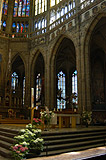 St Vitus Cathedral consists of the central nave with narrow aisles with small chapels and the norhern transept. The chapels are illuminated by the light going through coloured windows showing many sacred motives. Notice especially the window by Alfons Mucha, the representative of Art Nouveau.
St Vitus Cathedral consists of the central nave with narrow aisles with small chapels and the norhern transept. The chapels are illuminated by the light going through coloured windows showing many sacred motives. Notice especially the window by Alfons Mucha, the representative of Art Nouveau.
Famous chapels
The masterpiece of St Vitus Cathedral is St Wenceslas Chapel created in the 14th century by Charles IV in honour to the patron of Czech lands St Wenceslas. This chapel is known for its beautiful and rich decorations. Another admired work of art is the tombstone of John of Nepomuk situated opposite the John Nepomuk’s Chapel.
Triforium
Above the arches of the arcades you can see the busts of people that had merit in construction of the cathedral. The busts in the older part of the cathedral come from Petr Parler’s foundry.
Mausoleum and royal crypt
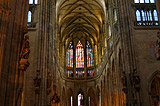 In front of the main altair of St Vitus Cathedral you’ll find the royal marble mausoleum with the royal crypt, where Bohemian kings were buried, underneath it. The mauzoleum consists of the tombstones of Ferdinand I of Austria, his wife Anna of Bohemia nad Hungary and the Holy Roman Emperor Maximilian II.
In front of the main altair of St Vitus Cathedral you’ll find the royal marble mausoleum with the royal crypt, where Bohemian kings were buried, underneath it. The mauzoleum consists of the tombstones of Ferdinand I of Austria, his wife Anna of Bohemia nad Hungary and the Holy Roman Emperor Maximilian II.
The royal crypt underneath the cathedral contains the graves of Charles IV, his four wives, Wenceslas IV, Ladislas the Posthumous, George of Podebrady, Rudolf II and the daughter of Maria Theresa of Austria Marie Amalie of Austria.
How to get there:
St Vitus Cathedral is the dominant of Prague Castle complex. You can get there by trams no. 22 and 23 from metro station Malostranska (stop Prazsky hrad) or from metro station Malostranska by old royal steps. There is a barrier-free access to the cathedral.
Opening times:
| * | Monday – Saturday | Sunday |
| November – February | 9:00 – 16:00 | 12:00 – 16:00 |
| March – October | 9:00 – 17:00 | 12:00 – 17:00 |
Entrance fee:
Since 5th April 2007 there is no entrance fee to St Vitus Cathedral.
Other information:
The Bell Tower is accessible only in good weather. It consists of 287 steps.
For more pictures see St Vitus Cathedral Photo Gallery